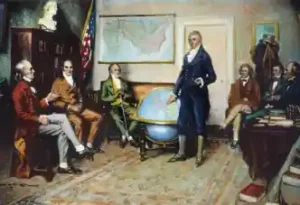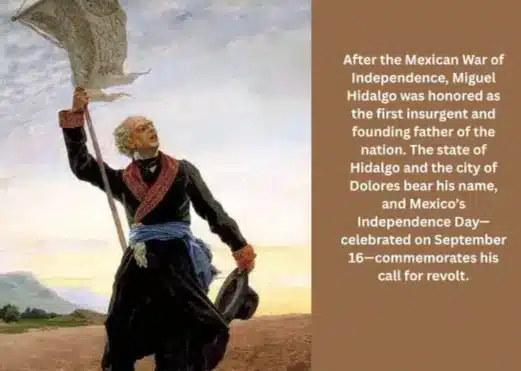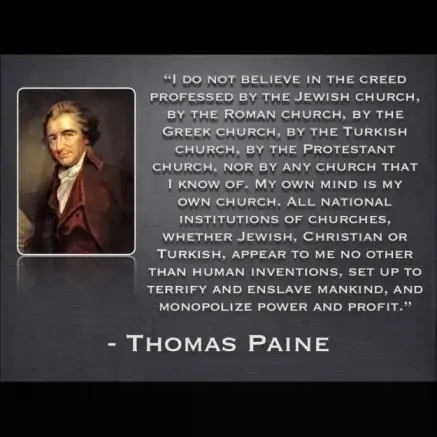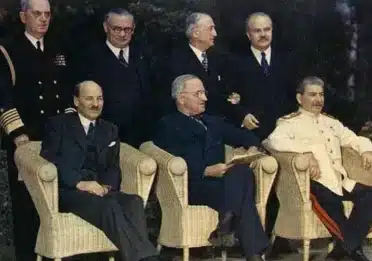Monroe Doctrine: A Pillar of U.S. Foreign Policy
The Monroe Doctrine, introduced by President James Monroe on December 2, 1823, was a significant U.S. foreign policy that stood against European colonialism in the Americas. It stated that any European interference in the political affairs of the Americas would be seen as a threat to U.S. security. This doctrine played a significant role in shaping American Grand Strategy throughout the 20th century, influencing subsequent Presidents and becoming a defining principle of U.S. foreign policy.
The Grand Strategy of the United States describes a diverse and flexible method toward national security and foreign policy goals. It aims to protect national interests, promote global stability and prosperity, maintain values and principles, and carefully assesses the military impacts while weighing the costs and benefits of policy decisions.
Notably, in the context, the word “Americas” refers to the combined continents of North America and South America, including Central America and the Caribbean. This region encompasses a diverse range of cultures, languages, and ecosystems, stretching from the Arctic in the north to the southern tip of South America. The United States’ introduction to geopolitics was primarily through the Monroe Doctrine – which originated in America first.

President James Monroe with his Cabinet, Image Source: Wikimedia Commons
This article aims to explore the broader context of the Monroe Doctrine within American foreign policy, highlighting its historical significance, its impact on European powers, and its controversial actions in relation to Latin America.
💻 Table of Contents:
- Warning to European Powers: The Message of the Monroe Doctrine
- Monroe’s Doctrine: A Dual Effort in Defining U.S. Influence in the Americas
- The fall of Maximilian: U.S. Intervention and the Monroe Doctrine
- Impact of the Monroe Doctrine: From Venezuela to the Roosevelt Corollary
- Evolution of the Monroe Doctrine: Revision to Modification
- Controversial Actions and Latin American Perspectives
- The Chinese Impact on Monroe Doctrine: A Brief Overview
- The Summit of the Americas: Resurrection of the Monroe Doctrine after Conclusion
Warning to European Powers: The Message of the Monroe Doctrine
One of the primary objectives of the Monroe Doctrine was to prevent European powers from extending their influence in the Western Hemisphere. At the time of its proclamation, several Latin American nations had recently gained independence from Spain and Portugal.
The United States, understanding that these new nations were defenseless, aimed to protect them from possible attempts by European countries to colonize them again. The doctrine effectively warned European powers that any attempt to establish new colonies or interfere in the internal affairs of American nations would be viewed as a hostile act towards the United States.
However, the Monroe Doctrine evolved over time, becoming a symbol of American supremacy and interventionism, receiving both praise and criticism. While it wasn’t entirely successful in its original intent to keep the U.S. out of European affairs, it had a profound impact on American foreign policy and solidified the U.S. as a prominent power in the Western Hemisphere.
In perspective of geostrategic thought, the Monroe Doctrine remains a central pillar of U.S. foreign policy, shaping American diplomacy for generations to come.
Monroe’s Doctrine: A Dual Effort in Defining U.S. Influence in the Americas
By the early 1820’s both Britain and the United States were concerned that European powers might try to bring back colonial rule in the region. Russia also raised fears of imperialism by asserting control over Pacific Northwest territory and prohibiting foreign ships from approaching its coast in 1821.
In these circumstances, George Canning, the British foreign minister to the U.S., proposed the idea of a joint U.S.-British declaration against future colonization in the Americas. U.S. President James Monroe, along with former presidents James Madison and Thomas Jefferson, showed support for the concept. However, U.S. Secretary of State John Quincy Adams opposed the joint declaration, fearing it would restrict U.S. expansion. Eventually, President Monroe sided with Adams and issued a unilateral declaration. So, the Monroe Doctrine was not the brainchild of a single individual, but rather a collaborative effort influenced by various figures.
President James Monroe delivered the doctrine’s core principles in his seventh annual message to Congress on December 2, 1823. However, it is important to note that while Monroe is associated with the doctrine, the actual formulation and drafting were a collaborative effort, with significant input from his Secretary of State, John Quincy Adams.
President Monroe’s role was crucial in announcing the vital principles of the doctrine, emphasizing two main points: non-colonization and non-intervention. The doctrine stated that European powers were not allowed to colonize the Americas any further, establishing the Western Hemisphere as an exclusive area of control for the newly independent nations of the Americas.
President Monroe’s speech laid the foundation for the United States to develop a clear foreign policy position in response to perceived threats from European powers attempting to regain influence following the independence movements in Latin America.
James Monroe’s steadfast commitment to emphasizing U.S. influence in the Western Hemisphere was complemented by the strategic wisdom of his Secretary of State, John Quincy Adams. Adams played a pivotal role in shaping the diplomatic language of the doctrine, infusing it with a tone of both warning and cooperation. Adams, a seasoned diplomat and later the sixth President of the United States, used his treasure of knowledge in diplomacy and his deep understanding of international relations to shape the Monroe Doctrine.
Together, Monroe and Adams crafted a policy that not only addressed the immediate concerns of European intervention but also laid the groundwork for U.S. foreign policy in the years to come. The Monroe Doctrine reflected a combination of idealism, as seen in its support for the principles of self-determination and non-colonization, and pragmatism, as it sought to defend U.S. interests in the Western Hemisphere.
The fall of Maximilian: U.S. Intervention and the Monroe Doctrine
The first major intervention of a European power in the New World after the Monroe Doctrine was the French intervention in Mexico during the 1860s.
In 1861, Mexico, under President Juárez, stopped paying its foreign debts, leading Spain, France, and Britain to agree on intervening. European forces landed in Veracruz in December 1861. While Britain and Spain withdrew after realizing France’s broader ambitions, French forces captured Mexico City.
In 1862, French Emperor Napoleon III sought to establish a French client state in Mexico, and eventually placed Maximilian of Habsburg, an Archduke of Austria, as the Emperor of Mexico. This move directly challenged the Monroe Doctrine, which aimed to prevent European colonization or interference in the Western Hemisphere.
The United States, despite being embroiled in its own internal conflicts, including the Civil War, strongly opposed French intervention in Mexico. President Abraham Lincoln’s administration rejected the recognition of Maximilian and French interference in Mexican affairs, considering it a violation of the Monroe Doctrine, but refrained from direct intervention due to the ongoing domestic crisis.
In 1865, the Monroe Doctrine was invoked as the United States provided diplomatic and military support to Mexican President Benito Juárez. This assistance helped Juárez lead a successful revolt against Emperor Maximilian, who had been installed by the French government.
President Andrew Johnson’s administration intensified diplomatic efforts to support Mexico’s resistance against the French-backed regime. The U.S. provided political and material support to Mexican President Benito Juárez and his forces, who fought to expel Maximilian and restore the republican government.
The U.S. government, invoking the Monroe Doctrine, issued diplomatic protests against France’s actions in Mexico and warned against any attempt to establish permanent European control in the region. While facing challenges at home, the U.S. Navy also maintained a presence in Mexican waters to deter further European encroachment.
After the American Civil War ended in 1865, Juárez’s forces began to succeed. Maximilian, unable to secure support from either Conservatives or Liberals, faced increasing difficulties. The French public grew tired of the intervention, and in January 1866, Napoleon III ordered French troops to withdraw, completed by November 1867.
U.S. Secretary of State William Seward warned Austria not to send its own troops to replace the French soldiers who were leaving Mexico. Because of this warning, Austria decided not to send any reinforcements to support Maximilian. Without the help of European troops, Maximilian was left without sufficient support. As a result, he was captured by Mexican forces, put on trial, and executed alongside his general Miguel Miramón, a former President of Mexico in June 1867, which brought an end to European intervention in Mexico.
The U.S. support for Mexico against the French-imposed Emperor Maximilian exemplified the Monroe Doctrine’s enduring influence on American foreign policy, reinforcing the principle of non-intervention and resistance to European interference in the Americas.
 |
| Image Credit: picryl.com, The Monroe Doctrine Must be Respected |
Impact of the Monroe Doctrine: From Venezuela to the Roosevelt Corollary
Initially, the Doctrine had limited immediate impact due to America’s relatively minor global influence. However, as U.S. power grew, the Doctrine began to shape U.S. actions, such as the Roosevelt Corollary and U.S. support for Mexico against the French-imposed Emperor Maximilian.
Venezuela and Germany clashed during the Venezuelan Crisis of 1902–1903. German traders dominated Venezuela’s economy, but turmoil in the late 19th century disrupted their interests. President Cipriano Castro’s refusal to pay foreign debts aggravated the situation.
In 1901, Germany encouraged Venezuela to seek international arbitration. The crisis escalated when Germany, along with Britain and Italy, imposed a naval blockade on Venezuela in 1902.
President Castro relied on the American Monroe Doctrine to deter European military intervention, but the United States interpreted the doctrine narrowly, focusing on territorial seizure rather than intervention. President Theodore Roosevelt supported European intervention in Venezuela to protect their citizens and property. In July 1901, he approved Germany’s debt collection plans but warned against territorial annexation. So, the U.S. remained officially neutral during the blockade.
Under pressure from the blockading nations, Venezuela agreed to address the claims brought against it, resulting in the lifting of the blockade. On February 13, 1903, Venezuela signed an agreement dedicating 30% of its customs duties to settling these claims.
💻 You May Also Like:
- The Age of Exploration: Christopher Columbus and the New World Discovery
- The Yalta Conference: A Political World-Order & American Plan
After eight decades of the Monroe Doctrine, when European powers began to intervene in the New World during the Venezuela Crisis, Argentine Minister of Foreign Affairs Luis María Drago, announced The Drago Doctrine in 1902 by aligned with the principles of the Monroe Doctrine, which aimed to keep Europe out of the Western Hemisphere.
The Drago Doctrine stated that foreign intervention, including by the United States, was not justified simply due to a nation’s failure to repay its debts. The United States accepted and supported the Drago Doctrine as it reinforced the principle of sovereign equality.
In response to the Drago Doctrine, President Roosevelt introduced the Roosevelt Corollary as a special addition to the Monroe Doctrine in 1904. It asserted America’s right to intervene in the Western Hemisphere to prevent future “chronic wrongdoing” and maintain order, stability, and prosperity.
Evolution of the Monroe Doctrine: Revision to Modification
Over time, the Monroe Doctrine underwent reinterpretation and adjustments to align with changing circumstances. In 1898, lawyers and intellectuals gave it a new meaning that emphasized working together with other countries and not intervening in their affairs. This change in interpretation was supported by President Franklin D. Roosevelt in 1933 when the United States helped establish the Organization of American States. This organization aimed to promote cooperation and respect among nations in the Americas.
In the 21st century, the Monroe Doctrine continues to be a topic of debate. Different people have criticized or supported it, and there have been arguments for its abandonment, restoration, or reimagining. Critics say the doctrine has been used to justify the US getting involved in Latin American countries’ internal affairs. Critics view it as a continuation of colonial thinking supporting neo-colonial relationships, while supporters argue it is necessary for protecting US interests and maintaining stability in the Americas.
Controversial Actions and Latin American Perspectives:
The Monroe Doctrine played a crucial role in shaping early American international relations. When we look at it from the viewpoint of Latin America, we see that it has many details and aspects. As time passed, the United States began to pursue policies that extended its influence and power, which included elements of hegemony (dominance) and imperialism (the practice of extending control over foreign territories). These policies evoked diverse reactions in Latin America. While the Monroe Doctrine initially aimed to protect Latin American nations from European colonization, the expansion of U.S. influence raised concerns among some Latin American countries. They viewed certain U.S. actions as infringing upon their sovereignty and independence.
Despite these complexities, the principles of the Monroe Doctrine fostered the idea of mutual guarantees among the nations of the Americas. It promoted the notion that American nations should support and protect each other from external threats or interventions. This sense of shared commitment and solidarity among American nations was a significant outcome of the Monroe Doctrine.
By fostering these ideas of mutual guarantees, the Monroe Doctrine helped shape a regional identity and collective foreign policy ethos in the Americas. It contributed to the notion that American countries should work together to defend their interests and maintain stability in the region.
The Organization of American States (OAS) was founded on April 30, 1948, to promote cooperation among its member countries in the Western Hemisphere. It aims to prevent outside intervention and maintain peace within the region. The OAS is based on the principles of the U.S. Monroe Doctrine, which states that an attack on one country in the Americas is seen as an attack on all. The OAS sought to expand on these principles, creating obligations for all member states while allowing the United States to defend itself if necessary.
One example of a controversial role that went against the principles of the Monroe Doctrine is the Falkland Islands conflict. In 1982, Argentina launched an invasion of the Falkland Islands, which are a British overseas territory located in the South Atlantic.
Documents reveal that the Reagan Administration secretly supported the UK during the Falklands War, despite publicly maintaining neutrality. This covert backing, including logistical and intelligence aid, sparked criticism from Latin American countries, who felt the U.S. neglected the Monroe Doctrine by not opposing European intervention in the Western Hemisphere. President Reagan’s administration aimed to appear neutral to influence Argentine behavior, but behind the scenes, they assured the UK of their support. This dual approach drew criticism from Latin American countries, as it appeared to align with a European power rather than supporting a fellow American nation.
Besides this very above history, over the years, several U.S. interventions in the Americas were justified or connected to the Monroe Doctrine:
1. Cuban War of Independence (1895-1898):
In 1898, the U.S. exercised its Monroe Doctrine prerogatives by intervening in support of Cuba’s war for independence from Spain, marking an early example of modern interventionism.
2. Venezuelan Crisis (1895):
The Venezuelan Boundary Dispute began in 1841 when Venezuela accused Britain of encroaching on its territory. Britain had acquired British Guiana in 1814 and defined its boundary in 1835, claiming additional land. In 1895, U.S. Secretary of State Richard Olney invoked the Monroe Doctrine, demanding Britain submit the dispute to arbitration.
Britain rejected the Monroe Doctrine’s validity in international law, leading President Grover Cleveland to seek Congressional approval for a boundary commission. This move, approved unanimously, brought the U.S. and Britain to the brink of war, highlighting the Monroe Doctrine’s significance in asserting U.S. influence in the Western Hemisphere.
The Anglo-Venezuelan boundary dispute was important because it showed the U.S. was starting to take a more active role in international affairs, especially in the Western Hemisphere. This incident marked the U.S. as a growing world power and demonstrated its willingness to enforce the Monroe Doctrine.
3. Dominican Republic (1904-1905):
The U.S. took over the customs houses of the Dominican Republic to manage its debt repayments and prevent European intervention, in line with the Roosevelt Corollary.
4. Nicaragua (1912-1933):
The U.S. intervened militarily and maintained a presence to protect its interests and maintain stability, invoking the Monroe Doctrine and later the Roosevelt Corollary.
5. Haiti (1915-1934):
The U.S. occupied Haiti following political instability and the threat of foreign (particularly German) intervention, justified under the Monroe Doctrine and Roosevelt Corollary.
6. Cuban Missile Crisis (1962):
In 1962, the Monroe Doctrine was symbolically invoked when the Soviet Union constructed missile-launching sites in Cuba. President John F. Kennedy, with the backing of the Organization of American States, imposed naval and air quarantine around the island. Following a period of heightened tension, the Soviet Union agreed to remove the missiles and dismantle the sites.
7. Roosevelt's Panama Canal and the Monroe Doctrine:
Theodore Roosevelt viewed the construction of the Panama Canal as his most significant foreign policy achievement. In 1903, he secured a treaty with the newly independent Panama, allowing the U.S. to build and control the canal. This move, while enhancing international commerce, was justified by Roosevelt as liberating Panama from Colombia. However, historians see it as imperialist, expanding U.S. power at the expense of Latin American sovereignty. The subsequent Roosevelt Corollary to the Monroe Doctrine asserted the U.S. right to exercise “international police power” in the Western Hemisphere, leading to repeated U.S. interventions in the region to maintain dominance.
 |
| Image Credit: Getarchive.net, The pull of the Monroe magnet |
The Chinese Impact on Monroe Doctrine: A Brief Overview
Over the past two decades, China has significantly increased its presence in Latin America through substantial investments in infrastructure, mining, and energy sectors as part of the Belt and Road Initiative. This economic engagement has led to China becoming a major trading partner for several Latin American countries. Additionally, diplomatic relations have strengthened, marked by high-level visits and the establishment of Confucius Institutes. Countries such as Panama and the Dominican Republic have shifted their diplomatic recognition from Taiwan to Beijing, reflecting China’s growing political influence in the region.
The U.S., viewing Latin America as its traditional sphere of influence under the Monroe Doctrine, has responded with concern to China’s expanding footprint. The Summit of the Americas, a forum for regional leaders to discuss issues affecting the Western Hemisphere, has become a platform for U.S. efforts to address China’s growing influence in Latin America.
💻 You May Also Read:
- The Acquisition of the Virgin Islands: A $25 million US-Denmark Gold Deal
- The Stimson Doctrine: A US World-Order in Terms of Territorial Changes
Under the Trump administration, the United States initiated the America Crece (Growth in the Americas) program in 2019. As strategic competition between the U.S. and China intensifies, Latin American countries are seeking to benefit from both superpowers while maintaining their sovereignty.
The Summit of the Americas: Resurrection of the Monroe Doctrine after Conclusion
In a speech at the Organization of American States on November 2013, Secretary of State John Kerry declared that the era of the Monroe Doctrine is over. He emphasized that the United States no longer sees itself as the unilateral protector of the region, but instead seeks equal partnerships and cooperation with Latin American countries. This shift reflects the changing dynamics in the region and the U.S.’s recognition of the emerging influence of other global powers. The remarks acknowledge a reduced U.S. influence in Latin American politics and a departure from past interventions.
The Ninth Summit of the Americas, June 2022 in Los Angeles, showcased a notable shift in the dynamics of power and diplomacy in the region, offering a renewed perspective on the Monroe Doctrine in the Americas. Joe Biden’s decision to exclude Cuba, Venezuela, and Nicaragua from the conference triggered widespread criticism and led to the boycott of several presidents.
This rejection of US policies and the emphasis on asserting sovereignty and autonomy reflects a departure from the historical dominance associated with the Monroe Doctrine. Countries across the Americas are now actively shaping their own paths, seeking regional cooperation through bodies like CELAC and UNASUR, while challenging US aggression and the antiquated principles of the Monroe Doctrine. The Summit signifies on “Building a Sustainable, Resilient, and Equitable Future” for the Hemisphere. The fact of the matter is that certain aspects of the Monroe Doctrine continue to persist through “The Summit of the Americas, a Renewed Resurrection of Monroe Doctrine,” which stands as one of the United States’ most significant accomplishments in geopolitics.
Conclusion:
Throughout the 19th century, the principles of the Monroe Doctrine were occasionally overlooked, leading to violations of its core principles. It was only in the early 1900s that the United States became powerful enough to effectively enforce the doctrine. This marked a significant moment in American foreign policy, as it solidified the doctrine’s importance and influence in shaping how the United States interacted with other nations.
In conclusion, the Monroe Doctrine played a significant role in shaping US grand strategy and its approach towards the Americas for many years. While it has evolved and faced criticism, its historical impact cannot be overlooked in understanding American foreign policy in the region.
Frequently Asked Questions
The Americas refer to the combined continents of North America and South America, including Central America and the Caribbean. This region is home to diverse cultures, languages, and ecosystems, stretching from the Arctic to the southern tip of South America.
The Monroe Doctrine, introduced by President James Monroe in 1823, opposed European colonialism in the Americas. It declared that any European interference in the region would be seen as a threat to U.S. security, shaping American foreign policy for centuries.
While not entirely successful in keeping the U.S. out of European affairs, the Monroe Doctrine solidified U.S. influence in the Western Hemisphere and became a cornerstone of American foreign policy, receiving both praise and criticism.
The U.S. Grand Strategy is a flexible approach to national security and foreign policy, aiming to protect national interests, promote global stability, uphold values, and carefully assess the costs and benefits of military and policy decisions.
The Monroe Doctrine was a collaborative effort. British Foreign Minister George Canning proposed the idea, while U.S. Secretary of State John Quincy Adams influenced its unilateral declaration by President James Monroe, opposing joint action with Britain. What do you mean by Americas?
What was the Monroe Doctrine in simple terms?
Was the Monroe Doctrine successful?
What is the United States' Grand Strategy?
Who was the mastermind behind the Monroe Doctrine?
The Roosevelt Corollary, added to the Monroe Doctrine in 1904, asserted America’s right to intervene in the Western Hemisphere to prevent “chronic wrongdoing” and maintain regional order, stability, and prosperity. What is the Roosevelt Corollary?








